What Is a Waterfall Countertop and Is It Right for Your Kitchen?
June 4, 2024
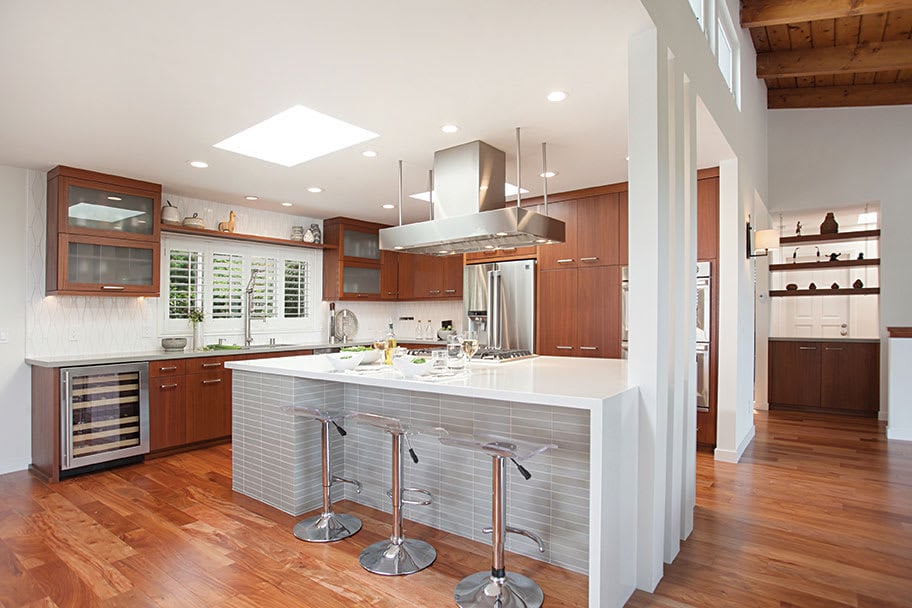
June 4, 2024

For contemporary kitchens, there’s nothing quite like the drama and simplicity of a waterfall countertop. “Consider a waterfall countertop as the kitchen's ultimate style hero, serving both as a functional countertop surface and visually striking focal point,” says Tyler Thompson, Caesarstone’s director of brand marketing for the Americas.
Although this clean-lined countertop has been popular for years, there are a few key things to consider before choosing the style for your own space. Here’s what the experts have to say about the installation, pricing, benefits, and potential disadvantages of a waterfall countertop.
A traditional countertop is a horizontal surface that sits on top of a base cabinet, whereas a waterfall countertop keeps going. “A waterfall countertop is a design feature where the countertop extends vertically down the sides of a cabinet or island all the way to the floor, the continuous design flow resembling a waterfall,” says Thompson.
“In their current iteration, waterfall countertops came into popularity about 10-15 years ago, though they have been around much longer,” says Crystal Hackl, owner and principal designer behind Inspired Haven Design. “They are a nod to the waterfall edges seen on Art Deco furniture in the '30s and '40s as well as mid-century modern furnishings, which evolved from curved waterfalls to square edges.”
It’s these edges that give today’s waterfall countertops their signature dramatic look. A waterfall countertop is meant to appear as one slab that’s been bent or folded from the countertop to the floor; it is the result of meticulous attention to detail in the planning and execution. Achieving the look requires precisely mitered edges: two separate pieces of material are cut at 45-degree angles and installed to appear as a seamless 90-degree angle on a single piece of material. It also requires the countertop material to be aligned to give off a continuous look—for example, marble veining patterns that run uninterrupted between horizontal and vertical surfaces.
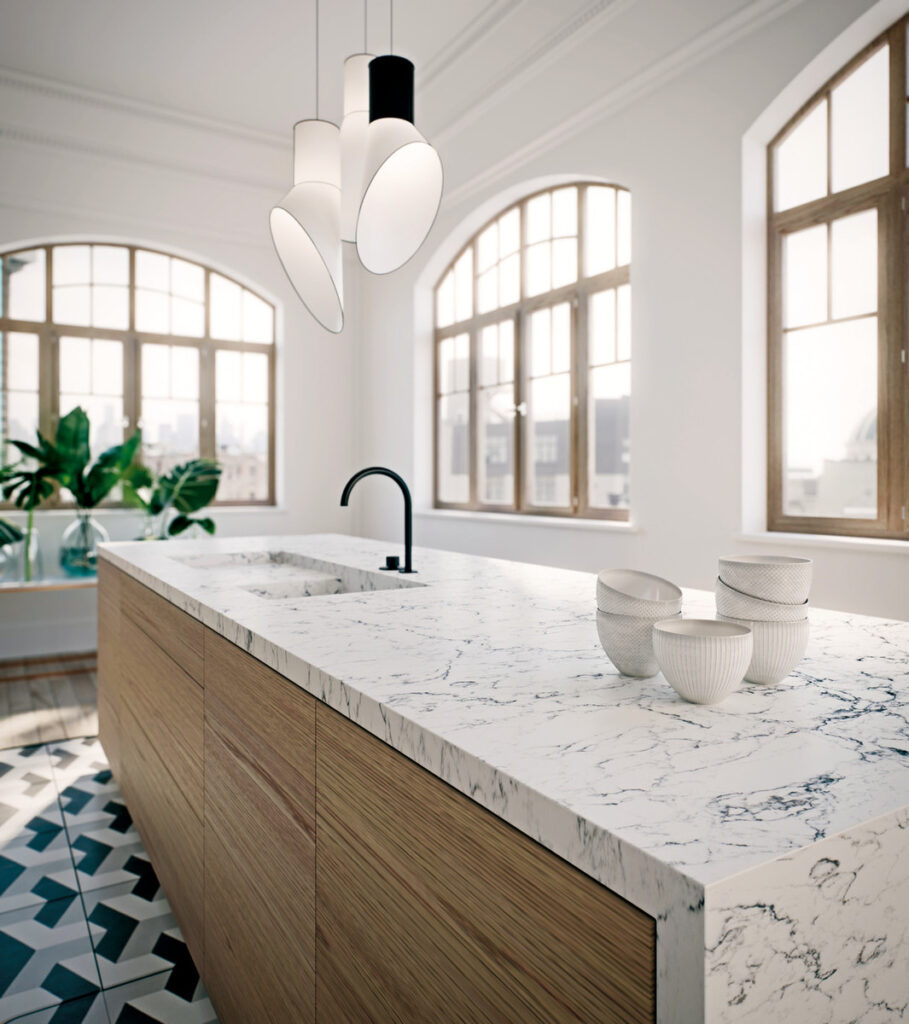
There are a few variations when it comes to the look and style of a waterfall countertop. A big factor is the number and location of the vertical sides. For example, it’s popular to have the waterfall side go down both ends of an island, but a single waterfall edge can be used to add asymmetrical drama. Similarly, a waterfall countertop can be limited to the end of a peninsula, or it can cover one or more exposed sides of a row of lower cabinetry, instead of a finished cabinet panel.
You can also get creative with waterfall length. “Most typically, that edge extends all the way to the floor, but there are some great examples of artful uses that extend down partially, as a cutaway to reveal another surface that extends to the floor,” says Crystal.
Waterfall countertops can be made from nearly any surface material, but some work better than others. “Most commonly, we see quartz and natural stone used, but nearly every countertop surface can be used to create a waterfall edge,” says Hackl. “Wood makes a particularly commanding statement."
“Waterfall countertops create drama, definition, and interest, while also signaling luxury and a modern feel,” says Hackl. These eye-catching installations elevate kitchens, but their sleek look is better suited for modern, contemporary, and transitional spaces. "If you prefer a more traditional style with a detailed counter edge, or softened corners, you may not feel at home with a waterfall countertop," says Hackl. Deciding if the contemporary, cascading look is a good fit for your kitchen is just one of the factors to consider when assessing if a waterfall countertop is right for your home.
“You’ll want to plan the function of the island or peninsula first and foremost and decide whether a waterfall edge will support your needs or not before committing to using them in your design,” advises Hackl. “They require more planning and potentially compromises."
For example, electrical placement can be more difficult with a waterfall countertop. Typically, the non-storage sides of lower cabinets are where outlets would go. However, with a waterfall countertop, there may be fewer available sides or locations for placement. "The last thing you’ll want is to put an outlet on your beautiful surface!” says Hackl. Planning ahead is key. “You’ll need to include enough outlets for convenience and to meet electrical codes requirements, and find a way to keep them off of your waterfall sides,” says Hackl.
Seating can also be a concern. While a waterfall countertop design can easily include an overhang that accommodates seating, you’ll need to consider if it allows for the placement and amount of seating that you’re hoping for.
Although a variety of countertop materials can be used to create the waterfall design, the material’s pattern can be a critical factor. A consistent pattern can make it easier to achieve an uninterrupted flowing look. “Especially if you want bold veining, opting for quartz or porcelain offers consistent patterns that can be book-matched to ensure your design flows cohesively down all sides of the waterfall,” says Thompson. “Natural stone options may present challenges due to variations in veining, potentially disrupting the seamless flow of the design.”
You’ll also want to consider the material’s compatibility with your lifestyle. For example, a waterfall countertop made from a material that requires sealing, like natural stone, will add another surface that requires routine care and maintenance.
The cascading portion of the waterfall also opens the countertop material to bumps, scratches, kicks, and other impacts that happen along ground level—but this is actually a bonus. "Waterfall edges can provide the strength and durability of countertop material onto the surface below, which adds a measure of protection from the activity of day-to-day life," says Thompson.
A waterfall countertop is generally more complex and nuanced than a convention countertop. The precision required means you need to find professionals who are comfortable and familiar with designing and implementing a waterfall countertop. “You’ll need a great fabricator and installation team to make sure the miter cuts and edges are aligned well,” says Hackl, who notes that this work is especially critical “to get good vein placement and alignment” when it comes to stone patterns.
Structurally, the vertical portion of the waterfall countertop can simply be a surface along the cabinet, or it can be used as an integral part of the structure by providing support for the horizontal countertop surface as well. “If the waterfall edge is also acting as a counter support, you’ll need to work that into the construction plan to create adequate strength and support,” advises Hackl.
Generally, waterfall countertops come with a higher price tag than traditional countertops. Like any countertop, the type of material, size, and style features like edge thickness impact cost; where waterfall countertops differ is in the amount of material, fabrication, and installation. “Waterfall countertops do require more material and precise fabrication and installation, so people should be prepared to invest a bit more for the design,” says Thompson. “It's all about the extra material and craftsmanship needed to achieve that seamless flow.”
The craftsmanship Thompson refers to includes fabrication and installation, which is more complex than a simple, traditional countertop because it requires precise cutting and alignment to achieve the sleek mitered edge. Estimates typically suggest additional fees of $1,000 to $2,000 for fabrication work1.
Waterfall countertops also require more material, adding to the expense. “You’ll need more countertop material to cover the additional surface area, plus extra material to align the veining on patterned surfaces,” says Hackl. “Depending on your countertop material thickness and finished edge thickness, you’ll need more material for the mitered edges and fabrication costs to polish and/or miter the edges,” she adds.
Once you know the key considerations, you can weigh the pros and cons for your space and lifestyle.
Pros
Cons
Stay up to date on the latest real estate trends.

August 25, 2025
Simple Sunday habits to help you shake the stress, stay organized, and roll into Monday with confidence.
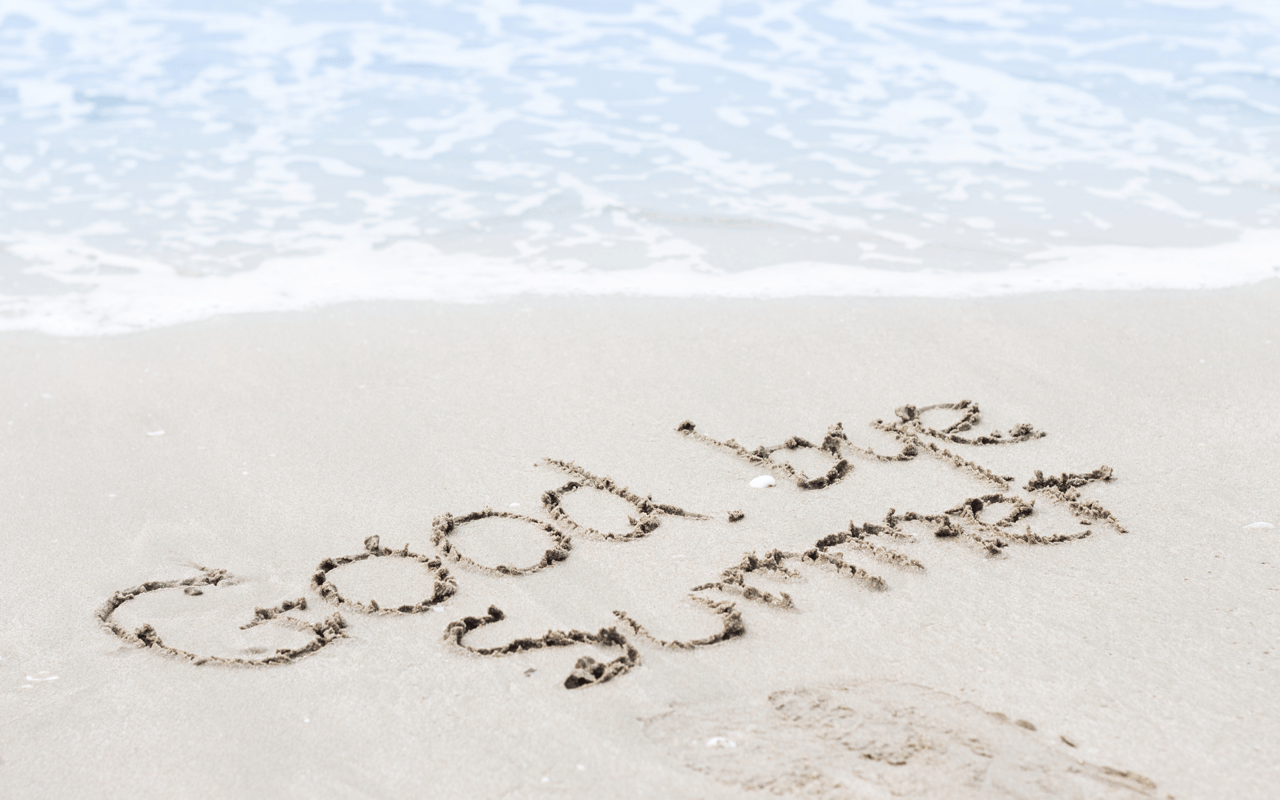
August 19, 2025
Local favorites, low-key adventures, and easy ways to savor the final days of summer in San Diego.
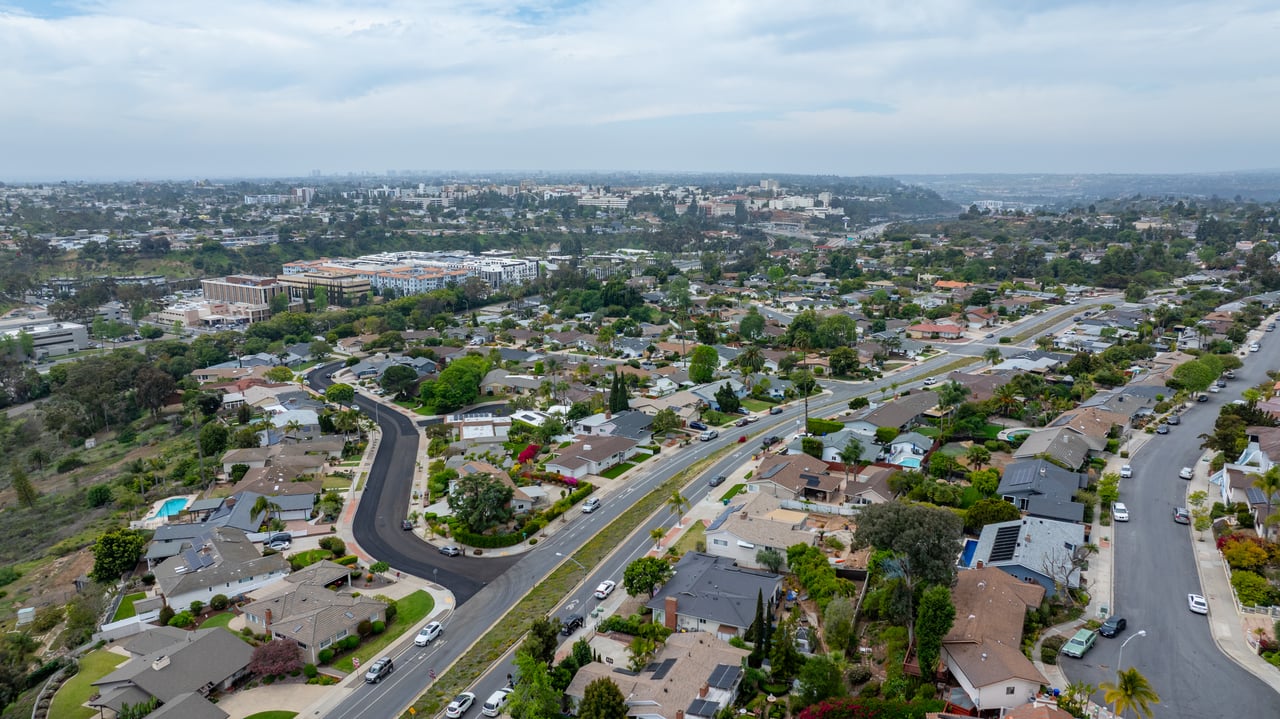
August 15, 2025
From scenic hikes to lakeside picnics, explore the top ways to enjoy the great outdoors in Del Cerro and its surrounding areas.

August 13, 2025
Simple design swaps to help your home feel cooler, improve airflow, and create a more comfortable living space—without sacrificing style.
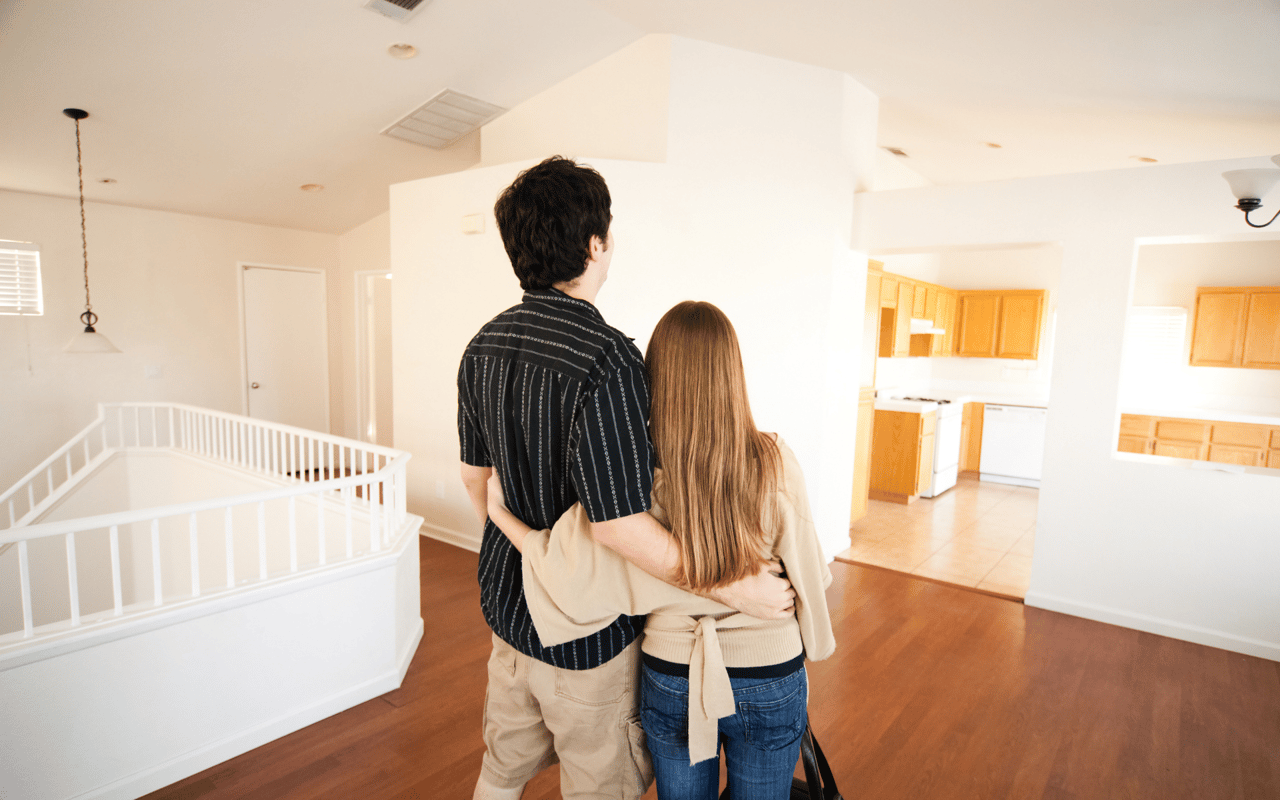
August 12, 2025
A clear, proven process to guide you from budgeting and preapproval to closing on your dream home in San Diego’s shifting market.

August 6, 2025
From contingencies to closing costs, here’s what sellers need to know to understand the full picture—not just the price tag.
You’ve got questions and we can’t wait to answer them.